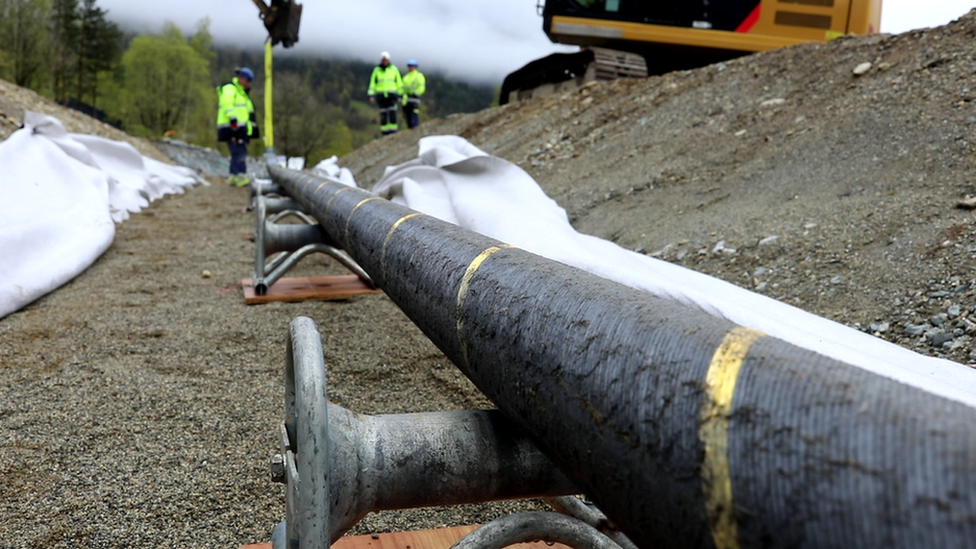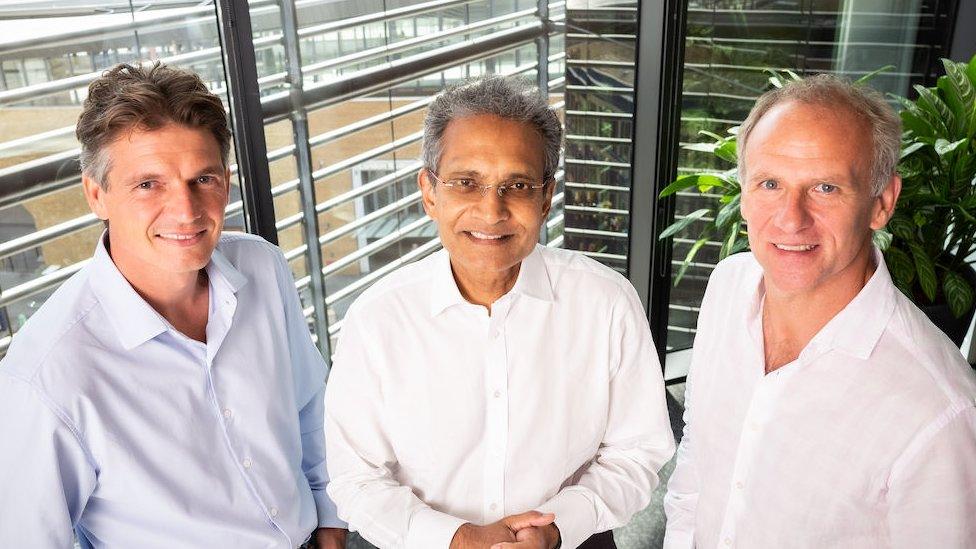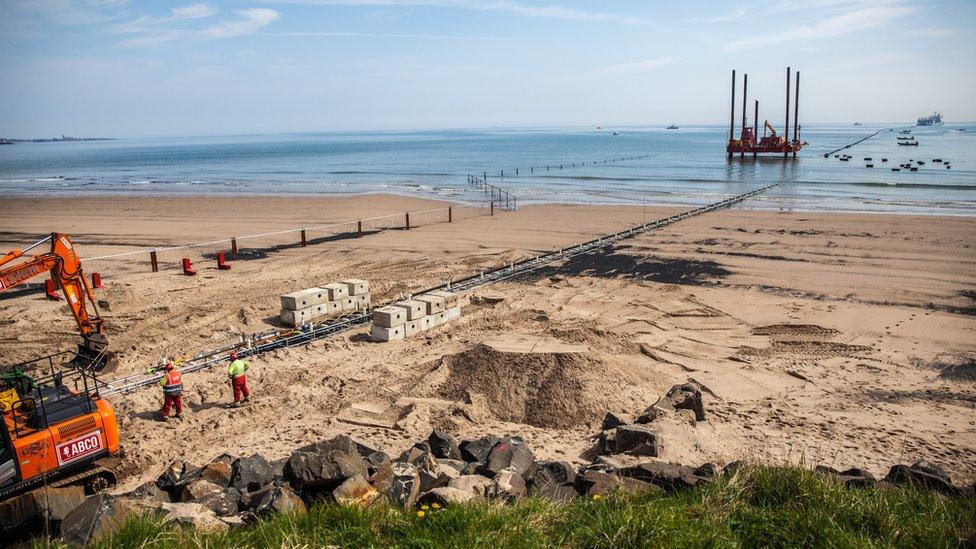How to plug the UK into desert sunshine
- Published

High power cables have to be handled carefully
If you wanted to build a gigantic new solar farm, you would probably choose the desert over Dartmoor.
Many have dreamed of exploiting the desert sun, but one of the challenges has always been how to export that electricity.
Xlinks, an energy start-up, says it has the answer with the world's longest under-sea power cable, external.
A total of four cables are planned to snake for 3,800km (2,360 miles) along the seabed from a solar and wind farm in Morocco past Portugal, Spain and France, before landing in the Devon village of Alverdiscott.
"It's absolutely doable," insists chief executive Simon Morrish. His firm hopes to have the project up and running by the end of the decade.
If all goes to plan, Xlinks' cable will provide 3.6 gigawatts of electricity, enough to power seven million homes, for 20 or more hours a day. It will join several similar, if shorter, lines that connect the UK's electricity grid to neighbouring countries.
Energy firms plan to establish even more under-sea power cables here and in other places around the world in the coming years. But what does it take to install them?
And with one connection between France and the UK recently knocked out of action due to a fire, are these cables really going to provide reliable sources of energy in the future?

Xlinks' leadership team Simon Morrish (left), Paddy Padmanathan and Sir Dave Lewis
"There's so much capacity going to be coming off the grid in the next five to 10 years, we desperately need to be able to increase that capacity," says Mr Morrish, referring to the UK.
A surplus of electricity from renewable resources is sometimes available in one country while a neighbouring nation is experiencing a shortfall in supply. It is relatively hard to store energy, especially long-term, so transferring it via a cable to your neighbour is in principle a good way to make sure it doesn't go to waste.
But no-one has yet built under-sea cable infrastructure on the scale proposed by Xlinks. Generally, a small trench is prepared in the seafloor to house cables like this, which are sometimes subsequently buried under concrete mattresses or rock.
The cable will follow a route that reaches 700m below sea-level at its deepest point - reducing the risk of damage from anchors and fishing gear. "It's not the shortest route to the UK but it has the lowest technical challenges. It will be buried below the surface the whole way along," Mr Morrish adds.
There will be some energy loss along the cable - 13% - but Xlinks says generation costs in Morocco will be low enough to ensure the project's viability.
The technology required to install cables of this length is already available says Behzad Kazemtabrizi at Durham University, some of whose work is sponsored by the government's Offshore Renewable Energy Catapult.
He says he is unaware of any other project planned on such a scale: "Certainly it's very ambitious."

Connecting the cable at each end could be one of the most challenging parts of the project
The trickiest part might come in connecting the cable to the assets at either end, however. Dr Kazemtabrizi explains that Xlinks will need to carefully choose the right equipment to manage its high voltage direct current cables, to avoid unwanted efficiency losses.
A "very, very detailed resource study" to ensure a reliable supply of sunshine at the Moroccan site is also crucial. Xlinks says it has already made an assessment based on satellite data and that a more detailed study using on-site wind masts and meteorological stations will take place soon.


Prof David Flynn at Heriot-Watt University says we are witnessing the start of a "boom time" in the under-sea power cable industry. That's partly thanks to heightened spending by various governments, external on renewables during the pandemic, in a push to accelerate job growth, external and decarbonisation.
These power lines are not just important for countries seeking to link their grids together - offshore wind farms, which are ever more popular, require under-sea cables, as well.
The recently completed North Sea Link, a 1.4 gigawatt connection between the UK and Norway, currently holds the title of world's longest under-sea power cable. At 720km, it is less than a fifth of the length of the cables required by Xlinks. However, North Sea Link had particularly challenging obstacles in its way at the Norwegian end, including a landlocked lake, a mountain and steep fjords.

The seabed can be extremely steep points out Caroline Opiyo-Mullings from National Grid
"It is so, so steep," says Caroline Opiyo-Mullings, project controls manager at National Grid, referring to the seabed that plunges to depths of up to 600m off the Norwegian coast. "There are parts that are steeper than a ski jump."
Installing any under-sea power line requires care, she explains, because the cables can only bend so much before they become damaged. As such, they must be gently lowered into position in favourable weather.
Plus, there are lots of other cables and pipelines on the seabed. You can't just dump new power lines over them without permission. Special structures sometimes have to be put in place in order to allow one cable to cross another, for instance. North Sea Link had to negotiate almost 100 crossings between Norway and the UK, says Mrs Opiyo-Mullings.
The next under-sea cable, Viking Link, will connect the UK to Denmark's grid. At 760km, it will be longer in terms of total length than North Sea Link, though a significantly larger portion of it, about 140km, will pass over land either in the UK or Denmark. That too requires careful planning, so small tunnels can be bored underneath roads and other infrastructure, for instance.
We should be cautious about the proliferation of under-sea power cables, says Prof Flynn. For one thing, there could be negative environmental consequences of increasing activity on the seabed.
One study recently found that brown crabs were mesmerised by under-sea electricity cables, external off the coast of Scotland, which could negatively affect their mating and foraging.
Plus, what if multiple cables get damaged by anchors or debris rolling around on the seabed? Or, worse, an adversary decides to sabotage them?
"It's something that I've discussed with both MoD in the UK as well as other agencies involved with our critical infrastructure," says Prof Flynn.
A spokeswoman for National Grid says: "We consider risks including security and implement measures starting with the design and construction of the asset. We would not disclose the details of those measures."
Xlinks says the recent interconnector fire reveals how important it is for the UK to diversify its sources of supply.
The company says that like all power generation projects, its project will never be 100% risk-free, "but by using the latest, proven and tested technology we can minimise risk to reliably deliver a complementary source of power for the British energy grid by the end of the decade".